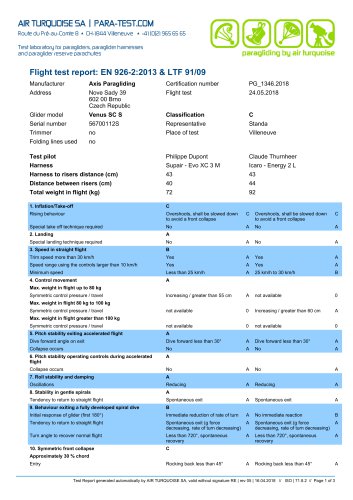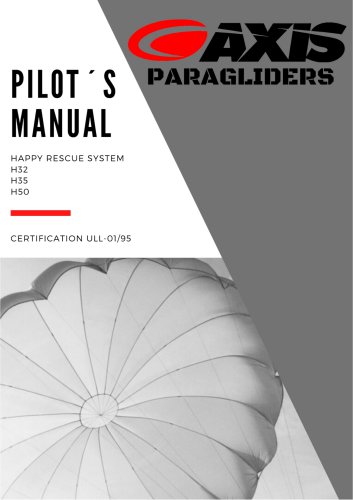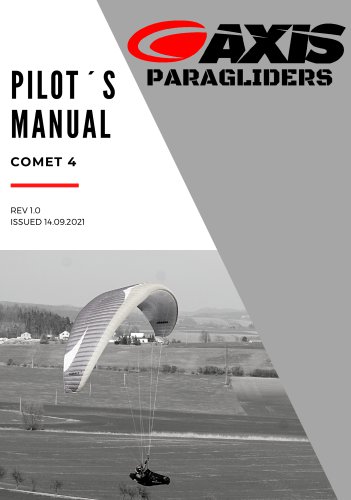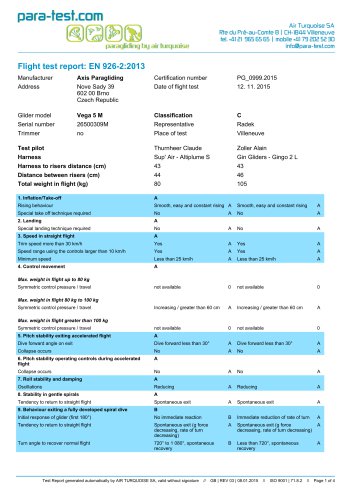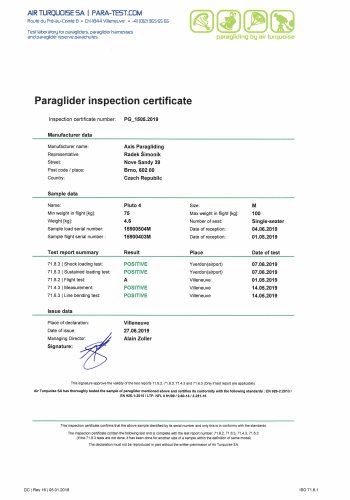
Catalog excerpts

Flight test report: EN 926-2:2013 & LTF 91/09 Manufacturer Axis Paragliding Certification number Nove Sady 39 602 00 Brno Czech Republic Flight test Glider model Serial number Folding lines used Test pilot Philippe Dupont Claude Thurnheer Harness to risers distance (cm) Distance between risers (cm) Total weight in flight (kg) Rising behaviour Overshoots, shall be slowed down to avoid a front collapse Overshoots, shall be slowed down to avoid a front collapse Special take off technique required Special landing technique required 3. Speed in straight flight Trim speed more than 30 km/h Speed range using the controls larger than 10 km/h Minimum speed A Increasing / greater than 55 cm Increasing / greater than 60 cm Symmetric control pressure / travel 5. Pitch stability exiting accelerated flight Dive forward angle on exit Dive forward less than 30° Dive forward less than 30° Collapse occurs 6. Pitch stability operating controls during accelerated flight Collapse occurs 7. Roll stability and damping 8. Stability in gentle spirals Tendency to return to straight flight Spontaneous exit Spontaneous exit 9. Behaviour exiting a fully developed spiral dive Initial response of glider (first 180°) Immediate reduction of rate of turn Tendency to return to straight flight Spontaneous exit (g force decreasing, rate of turn decreasing) Spontaneous exit (g force decreasing, rate of turn decreasing) Turn angle to recover normal flight Less than 720°, spontaneous recovery Less than 720°, spontaneous recovery 10. Symmetric front collapse Rocking back less than 45° Max. weight in flight up to 80 kg Symmetric control pressure / travel Max. weight in flight 80 kg to 100 kg Symmetric control pressure / travel Max. weight in flight greater than 100 kg Approximately 30 % chord Entry Rocking back less than 45° Test Report generated automatically by AIR TURQUOISE SA, valid without signature RE | rev 05 | 16.04.2018 // ISO | 71.8.2 // Page 1
Open the catalog to page 1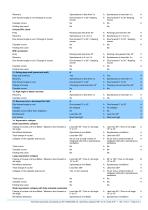
Spontaneous in less than 3 s Spontaneous in less than 3 s Dive forward angle on exit Change of course Dive forward 0° to 30° Keeping course Dive forward 0° to 30° Keeping course Cascade occurs Folding lines used At least 50% chord Entry Rocking back less than 45° Rocking back less than 45° Dive forward angle on exit / Change of course Dive forward 0° to 30° / Keeping course Dive forward 0° to 30° / Keeping course Cascade occurs Folding lines used With accelerator Entry Rocking back less than 45° Rocking back greater than 45° Spontaneous in less than 3 s Dive forward angle on exit / Change...
Open the catalog to page 2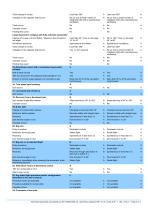
Total change of course Collapse on the opposite side occurs No (or only a small number of collapsed cells with a spontaneous reinflation) No (or only a small number of collapsed cells with a spontaneous reinflation) Twist occurs Cascade occurs Folding lines used Large asymmetric collapse with fully activated accelerator Change of course until re-inflation / Maximum dive forward or roll angle Less than 90° / Dive or roll angle 15° to 45° 90° to 180° / Dive or roll angle 45° to 60° Re-inflation behaviour Spontaneous re-inflation Spontaneous re-inflation Total change of course Collapse on the...
Open the catalog to page 3All Axis catalogs and technical brochures
-
Happy rescue system
14 Pages
-
COMET 4
22 Pages
-
VEGA 5 Flight test report M
4 Pages

